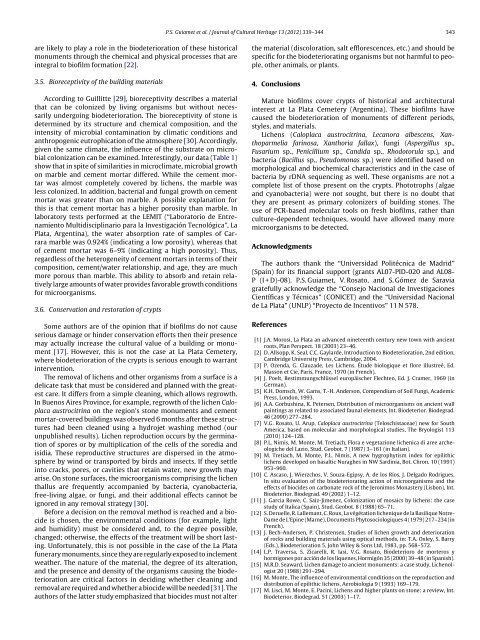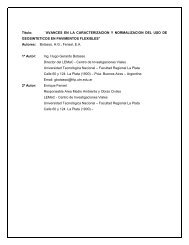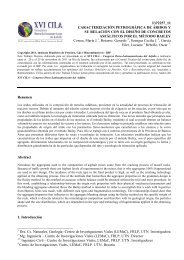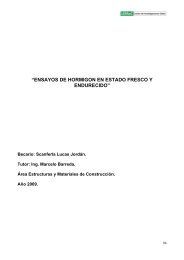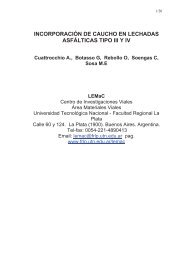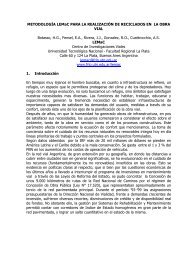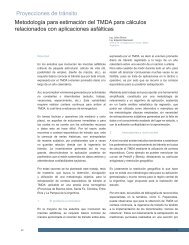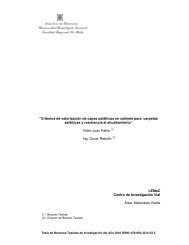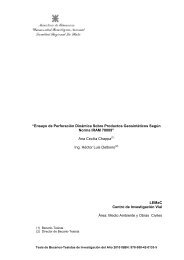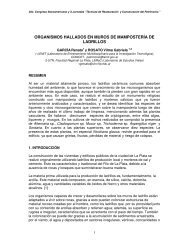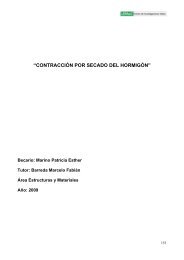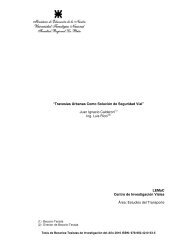Biofouling of crypts of historical and architectural interest at La Plata ...
Biofouling of crypts of historical and architectural interest at La Plata ...
Biofouling of crypts of historical and architectural interest at La Plata ...
You also want an ePaper? Increase the reach of your titles
YUMPU automatically turns print PDFs into web optimized ePapers that Google loves.
are likely to play a role in the biodeterior<strong>at</strong>ion <strong>of</strong> these <strong>historical</strong><br />
monuments through the chemical <strong>and</strong> physical processes th<strong>at</strong> are<br />
integral to bi<strong>of</strong>ilm form<strong>at</strong>ion [22].<br />
3.5. Bioreceptivity <strong>of</strong> the building m<strong>at</strong>erials<br />
According to Guillitte [29], bioreceptivity describes a m<strong>at</strong>erial<br />
th<strong>at</strong> can be colonized by living organisms but without necessarily<br />
undergoing biodeterior<strong>at</strong>ion. The bioreceptivity <strong>of</strong> stone is<br />
determined by its structure <strong>and</strong> chemical composition, <strong>and</strong> the<br />
intensity <strong>of</strong> microbial contamin<strong>at</strong>ion by clim<strong>at</strong>ic conditions <strong>and</strong><br />
anthropogenic eutrophic<strong>at</strong>ion <strong>of</strong> the <strong>at</strong>mosphere [30]. Accordingly,<br />
given the same clim<strong>at</strong>e, the influence <strong>of</strong> the substr<strong>at</strong>e on microbial<br />
coloniz<strong>at</strong>ion can be examined. Interestingly, our d<strong>at</strong>a (Table 1)<br />
show th<strong>at</strong> in spite <strong>of</strong> similarities in microclim<strong>at</strong>e, microbial growth<br />
on marble <strong>and</strong> cement mortar differed. While the cement mortar<br />
was almost completely covered by lichens, the marble was<br />
less colonized. In addition, bacterial <strong>and</strong> fungal growth on cement<br />
mortar was gre<strong>at</strong>er than on marble. A possible explan<strong>at</strong>ion for<br />
this is th<strong>at</strong> cement mortar has a higher porosity than marble. In<br />
labor<strong>at</strong>ory tests performed <strong>at</strong> the LEMIT (“<strong>La</strong>bor<strong>at</strong>orio de Entrenamiento<br />
Multidisciplinario para la Investigación Tecnológica”, <strong>La</strong><br />
Pl<strong>at</strong>a, Argentina), the w<strong>at</strong>er absorption r<strong>at</strong>e <strong>of</strong> samples <strong>of</strong> Carrara<br />
marble was 0.924% (indic<strong>at</strong>ing a low porosity), whereas th<strong>at</strong><br />
<strong>of</strong> cement mortar was 6–9% (indic<strong>at</strong>ing a high porosity). Thus,<br />
regardless <strong>of</strong> the heterogeneity <strong>of</strong> cement mortars in terms <strong>of</strong> their<br />
composition, cement/w<strong>at</strong>er rel<strong>at</strong>ionship, <strong>and</strong> age, they are much<br />
more porous than marble. This ability to absorb <strong>and</strong> retain rel<strong>at</strong>ively<br />
large amounts <strong>of</strong> w<strong>at</strong>er provides favorable growth conditions<br />
for microorganisms.<br />
3.6. Conserv<strong>at</strong>ion <strong>and</strong> restor<strong>at</strong>ion <strong>of</strong> <strong>crypts</strong><br />
Some authors are <strong>of</strong> the opinion th<strong>at</strong> if bi<strong>of</strong>ilms do not cause<br />
serious damage or hinder conserv<strong>at</strong>ion efforts then their presence<br />
may actually increase the cultural value <strong>of</strong> a building or monument<br />
[17]. However, this is not the case <strong>at</strong> <strong>La</strong> Pl<strong>at</strong>a Cemetery,<br />
where biodeterior<strong>at</strong>ion <strong>of</strong> the <strong>crypts</strong> is serious enough to warrant<br />
intervention.<br />
The removal <strong>of</strong> lichens <strong>and</strong> other organisms from a surface is a<br />
delic<strong>at</strong>e task th<strong>at</strong> must be considered <strong>and</strong> planned with the gre<strong>at</strong>est<br />
care. It differs from a simple cleaning, which allows regrowth.<br />
In Buenos Aires Province, for example, regrowth <strong>of</strong> the lichen Caloplaca<br />
austrocitrina on the region’s stone monuments <strong>and</strong> cement<br />
mortar-covered buildings was observed 6 months after these structures<br />
had been cleaned using a hydrojet washing method (our<br />
unpublished results). Lichen reproduction occurs by the germin<strong>at</strong>ion<br />
<strong>of</strong> spores or by multiplic<strong>at</strong>ion <strong>of</strong> the cells <strong>of</strong> the soredia <strong>and</strong><br />
isidia. These reproductive structures are dispersed in the <strong>at</strong>mosphere<br />
by wind or transported by birds <strong>and</strong> insects. If they settle<br />
into cracks, pores, or cavities th<strong>at</strong> retain w<strong>at</strong>er, new growth may<br />
arise. On stone surfaces, the microorganisms comprising the lichen<br />
thallus are frequently accompanied by bacteria, cyanobacteria,<br />
free-living algae, or fungi, <strong>and</strong> their additional effects cannot be<br />
ignored in any removal str<strong>at</strong>egy [30].<br />
Before a decision on the removal method is reached <strong>and</strong> a biocide<br />
is chosen, the environmental conditions (for example, light<br />
<strong>and</strong> humidity) must be considered <strong>and</strong>, to the degree possible,<br />
changed; otherwise, the effects <strong>of</strong> the tre<strong>at</strong>ment will be short lasting.<br />
Unfortun<strong>at</strong>ely, this is not possible in the case <strong>of</strong> the <strong>La</strong> Pl<strong>at</strong>a<br />
funerary monuments, since they are regularly exposed to inclement<br />
we<strong>at</strong>her. The n<strong>at</strong>ure <strong>of</strong> the m<strong>at</strong>erial, the degree <strong>of</strong> its alter<strong>at</strong>ion,<br />
<strong>and</strong> the presence <strong>and</strong> density <strong>of</strong> the organisms causing the biodeterior<strong>at</strong>ion<br />
are critical factors in deciding whether cleaning <strong>and</strong><br />
removal are required <strong>and</strong> whether a biocide will be needed [31]. The<br />
authors <strong>of</strong> the l<strong>at</strong>ter study emphasized th<strong>at</strong> biocides must not alter<br />
P.S. Guiamet et al. / Journal <strong>of</strong> Cultural Heritage 13 (2012) 339–344 343<br />
the m<strong>at</strong>erial (discolor<strong>at</strong>ion, salt efflorescences, etc.) <strong>and</strong> should be<br />
specific for the biodeterior<strong>at</strong>ing organisms but not harmful to people,<br />
other animals, or plants.<br />
4. Conclusions<br />
M<strong>at</strong>ure bi<strong>of</strong>ilms cover <strong>crypts</strong> <strong>of</strong> <strong>historical</strong> <strong>and</strong> <strong>architectural</strong><br />
<strong>interest</strong> <strong>at</strong> <strong>La</strong> Pl<strong>at</strong>a Cemetery (Argentina). These bi<strong>of</strong>ilms have<br />
caused the biodeterior<strong>at</strong>ion <strong>of</strong> monuments <strong>of</strong> different periods,<br />
styles, <strong>and</strong> m<strong>at</strong>erials.<br />
Lichens (Caloplaca austrocitrina, Lecanora albescens, Xanthoparmelia<br />
farinosa, Xanthoria fallax), fungi (Aspergillus sp.,<br />
Fusarium sp., Penicillium sp., C<strong>and</strong>ida sp., Rhodotorula sp.), <strong>and</strong><br />
bacteria (Bacillus sp., Pseudomonas sp.) were identified based on<br />
morphological <strong>and</strong> biochemical characteristics <strong>and</strong> in the case <strong>of</strong><br />
bacteria by rDNA sequencing as well. These organisms are not a<br />
complete list <strong>of</strong> those present on the <strong>crypts</strong>. Phototrophs (algae<br />
<strong>and</strong> cyanobacteria) were not sought, but there is no doubt th<strong>at</strong><br />
they are present as primary colonizers <strong>of</strong> building stones. The<br />
use <strong>of</strong> PCR-based molecular tools on fresh bi<strong>of</strong>ilms, r<strong>at</strong>her than<br />
culture-dependent techniques, would have allowed many more<br />
microorganisms to be detected.<br />
Acknowledgments<br />
The authors thank the “Universidad Politécnica de Madrid”<br />
(Spain) for its financial support (grants AL07-PID-020 <strong>and</strong> AL08-<br />
P (I + D)-08). P.S. Guiamet, V. Ros<strong>at</strong>o, <strong>and</strong> S. Gómez de Saravia<br />
gr<strong>at</strong>efully acknowledge the “Consejo Nacional de Investigaciones<br />
Científicas y Técnicas” (CONICET) <strong>and</strong> the “Universidad Nacional<br />
de <strong>La</strong> Pl<strong>at</strong>a” (UNLP) “Proyecto de Incentivos” 11 N 578.<br />
References<br />
[1] J.A. Morosi, <strong>La</strong> Pl<strong>at</strong>a an advanced nineteenth century new town with ancient<br />
roots, Plan Perspect. 18 (2003) 23–46.<br />
[2] D. Allsopp, K. Seal, C.C. Gaylarde, Introduction to Biodeterior<strong>at</strong>ion, 2nd edition,<br />
Cambridge University Press, Cambridge, 2004.<br />
[3] P. Ozenda, G. Clauzade, Les Lichens. Étude biologique et flore illustreé, Ed.<br />
Masson et Cie, Paris, France, 1970 (in French).<br />
[4] J. Poelt, Bestimmungschlüssel europäischer Flechten, Ed. J. Cramer, 1969 (in<br />
German).<br />
[5] K.H. Domsch, W. Gams, T.-H. Anderson, Compendium <strong>of</strong> Soil Fungi, Academic<br />
Press, London, 1993.<br />
[6] A.A. Gorbushina, K. Petersen, Distribution <strong>of</strong> microorganisms on ancient wall<br />
paintings as rel<strong>at</strong>ed to associ<strong>at</strong>ed faunal elements, Int. Biodeterior. Biodegrad.<br />
46 (2000) 277–284.<br />
[7] V.G. Ros<strong>at</strong>o, U. Arup, Caloplaca austrocitrina (Teloschistaceae) new for South<br />
America, based on molecular <strong>and</strong> morphological studies, The Bryologist 113<br />
(2010) 124–128.<br />
[8] P.L. Nimis, M. Monte, M. Tretiach, Flora e vegetazione lichenica di aree archeologiche<br />
del <strong>La</strong>zio, Stud. Geobot. 7 (1987) 3–161 (in Italian).<br />
[9] M. Tretiach, M. Monte, P.L. Nimis, A new hygrophytism index for epilithic<br />
lichens developed on basaltic Nuraghes in NW Sardinia, Bot. Chron. 10 (1991)<br />
953–960.<br />
[10] C. Ascaso, J. Wierzchos, V. Souza-Egipsy, A. de los Ríos, J. Delgado Rodrigues,<br />
In situ evalu<strong>at</strong>ion <strong>of</strong> the biodeterior<strong>at</strong>ing action <strong>of</strong> microorganisms <strong>and</strong> the<br />
effects <strong>of</strong> biocides on carbon<strong>at</strong>e rock <strong>of</strong> the Jeronimos Monastery (Lisbon), Int.<br />
Biodeterior. Biodegrad. 49 (2002) 1–12.<br />
[11] J. Garcia Rowe, C. Saiz-Jimenez, Coloniz<strong>at</strong>ion <strong>of</strong> mosaics by lichens: the case<br />
study <strong>of</strong> Italica (Spain), Stud. Geobot. 8 (1988) 65–71.<br />
[12] S. Deruelle, R. <strong>La</strong>llemant, C. Roux, <strong>La</strong> végét<strong>at</strong>ion lichenique de la Basilique Notre-<br />
Dame de L’Epine (Marne), Documents Phytosociologiques 4 (1979) 217–234 (in<br />
French).<br />
[13] J. Bech-Andersen, P. Christensen, Studies <strong>of</strong> lichen growth <strong>and</strong> deterior<strong>at</strong>ion<br />
<strong>of</strong> rocks <strong>and</strong> building m<strong>at</strong>erials using optical methods, in: T.A. Oxley, S. Barry<br />
(Eds.), Biodeterior<strong>at</strong>ion 5, John Wiley & Sons Ltd, 1983, pp. 568–572.<br />
[14] L.P. Traversa, S. Zicarelli, R. Iasi, V.G. Ros<strong>at</strong>o, Biodeterioro de morteros y<br />
hormigones por acción de los líquenes, Hormigón 35 (2000) 39–48 (in Spanish).<br />
[15] M.R.D. Seaward, Lichen damage to ancient monuments: a case study, Lichenologist<br />
20 (1988) 291–294.<br />
[16] M. Monte, The influence <strong>of</strong> environmental conditions on the reproduction <strong>and</strong><br />
distribution <strong>of</strong> epilithic lichens, Aerobiologia 9 (1993) 169–179.<br />
[17] M. Lisci, M. Monte, E. Pacini, Lichens <strong>and</strong> higher plants on stone: a review, Int.<br />
Biodeterior. Biodegrad. 51 (2003) 1–17.


